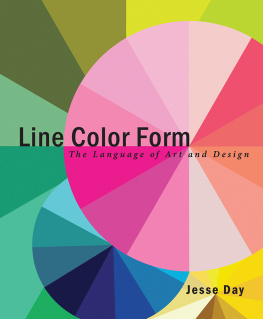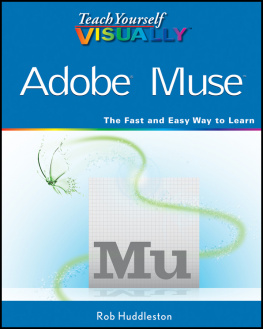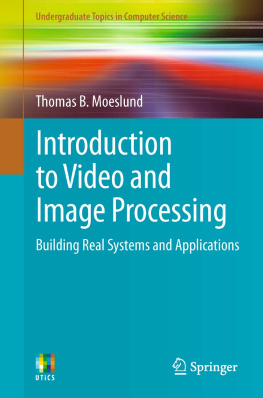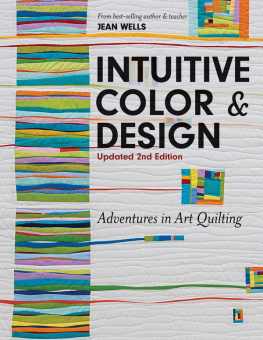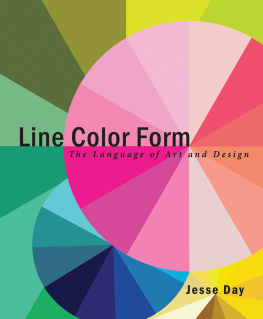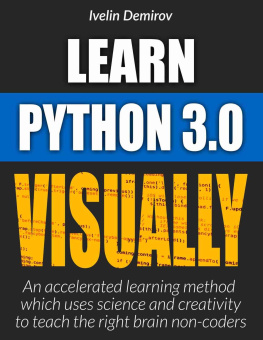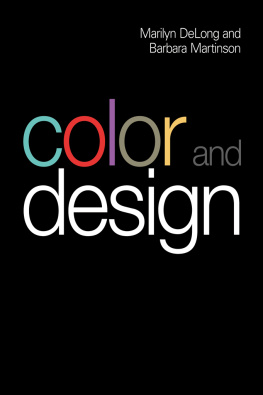Line Color Form
The Language of Art and Design
Jesse Day

Copyright 2013 by Jesse Day
All Rights Reserved. Copyright under Berne Copyright Convention, Universal Copyright Convention, and Pan American Copyright Convention. No part of this book may be reproduced, stored in a retrieval system, or transmitted in any form, or by any means, electronic, mechanical, photocopying, recording or otherwise, without the express written consent of the publisher, except in the case of brief excerpts in critical reviews or articles. All inquiries should be addressed to Allworth Press, 307 West 36th Street, 11th Floor, New York, NY 10018.
Allworth Press books may be purchased in bulk at special discounts for sales promotion, corporate gifts, fund-raising, or educational purposes. Special editions can also be created to specifications. For details, contact the Special Sales Department, Allworth Press, 307 West 36th Street, 11th Floor, New York, NY 10018 or info@skyhorsepublishing.com.
15 14 13 12 11 5 4 3 2 1
Published by Allworth Press, an imprint of Skyhorse Publishing, Inc.
307 West 36th Street, 11th Floor, New York, NY 10018.
Allworth Press is a registered trademark of Skyhorse Publishing, Inc., a Delaware corporation.
www.allworth.com
Cover and interior design by Jesse Day
Graphic design by Soo Jin Kang
Library of Congress Cataloging-in-Publication Data is available on file.
ISBN: 978-1-62153-244-6
Printed in China
The beginning of wisdom is calling things by their right name.
John Dillow, high school geometry teacher
Contents

| CHAPTER 1
Line |

| CHAPTER 2
Color |

| CHAPTER 3
Composition |

| CHAPTER 4
Material |

| CHAPTER 5
Formal Analysis |

|
Acknowledgments
To begin with, I must express my immeasurable gratitude to my chief collaborator and co-visionary Soo Jin Kang. Not only did Soo Jin graciously dedicate countless hours of creative energy to the graphic design and layout of this book, but as a student of both art and the English language, she provided the invaluable service of keeping me grounded in the audience and their needs. Since the inception of this project, Soo Jin has kept a constant eye on my blind spots, provided clever solutions to a host of baffling problems, and demonstrated the remarkable courage to shoot down so many of my brilliant ideas. This book would not have been possible without her.
To my wife, Ananda Day Cavalli, who provided the majority of the still life and landscape photography for the book, who spent the Fourth of July with me designing the cover, who nourished the project from its infancy with a bottomless well of encouragement, and whose insightful counsel helped steer me around the most impervious of roadblocks, my gratitude knows no bounds.
So many of my colleagues and friends at Parsons have supported me through this project, from offering practical advice to piloting my materials in their classes, that it would be impossible to list you all by name, but you are all enormously appreciated. A special thank you to Anne Gaines, Joe Hosking, Jaclyn Lovell, and especially Caitlin Morgan, who championed this project from day one and would not give up until it found its way into the right hands. I would also like to extend my debt of gratitude to The New School Office of the Provost, whose generous grant of the Innovations in Education Fund provided the fuel to turn this spark of an idea into a full-blown fire.
Finally, I would like to thank my students, whose magnificent blend of imagination and tenacity has so inspired me over the years. This book is my gift to you, and I hope that it makes the art and design school experience more enriching and enjoyable for all those to come.
Introduction
A Visual Guide for Visual Learners
I first came up with the idea to create a visual guide to the language of art and design during a tutoring session with a South Korean communications design student. She had chosen Van Goghs Starry Night as her inspiration for a project and we were working together on a formal analysis of the piece. I was trying to elicit descriptive vocabulary from her so that she could explain, in her own words, what it was about the colors, lines, or composition of the piece that had so inspired her.
She stared in silence at the painting for a little while. Then she took a deep breath, glanced shyly at me, and whispered, Blue?
Yes, but what about the blue?
Its... beautiful.
Anything else?
Yellow?
How about the lines?
She bit her lip. Curved? she asked.
Here was a bright young woman, an accomplished painter, a gifted designer studying at Parsons, a top art and design school in New York City, and she was utfterly incapable of describing what was right before her eyes. It wasnt her fault. When would she ever have learned the words for swirling and spiraling lines, heavily caked pigment, splotched and smeared brushstrokes? And the colors! The lemon yellow stars and the saffron moon, the intermingling cobalt and cornflower blues that spin above that darkest bistre landscape. Never in her first-rate private art education had she had the opportunity to learn how to talk about art. A picture is worth a thousand words, but where do we get those words when we want to discuss the picture?
I reached out to a number of colleagues at art and design colleges across the country, and sure enough this was a problem that seemed to plague international students everywhere. What I was surprised to discover, however, is how much difficulty native speakers were having as well. Any writer will tell you that simply describing what you see in front of you is one of the hardest things to do. It is certainly a language problem, but it is also a way-of-thinking problem. Visually oriented people, whether English is their first language or not, often have trouble expressing themselves linguistically because they are more comfortable communicating in images. Vision precedes language in our psychic development, and for many artistic people it remains the dominant mode of conceptualization throughout our lives. We think in pictures. Translating picture to language is a daunting task, one that is even more challenging for non-native speakers who are juggling three languages: native tongue, English, and image. What is needed, I thought, is some sort of image-to-word translation book for the language of art and design. The idea seemed pretty obvious, and I was shocked to discover that one didnt already exist, but at the time I had no idea how to go about creating such a thing.
Many people think of the verbal and the visual as being totally separate, disconnected modes of thinking. People tend to self-identify as either artistic or intellectual. This identification is usually established in childhood, the result of a natural talent or affinity for one path or the other and the accompanying praise or discouragement from parents and teachers. This self-imposed division not only sells us short of our full potential, it has caused many communication problems in the realm of art and design education. In the academic community of students and teachers, we have a lot of intellectuals who write brilliant analytical prose, but package it in dense tomes that are impenetrable to the visuals, and a lot of artists who make beautiful work, but cant explain its significance to the verbals. Our design libraries are filled with exhaustive treatises on color theory that contain but one or two pictures, and superficial image books with but a few lines of unhelpful text. Every year the images look more sparkly, the textbooks look more musty, and these two icebergs drift further apart.

